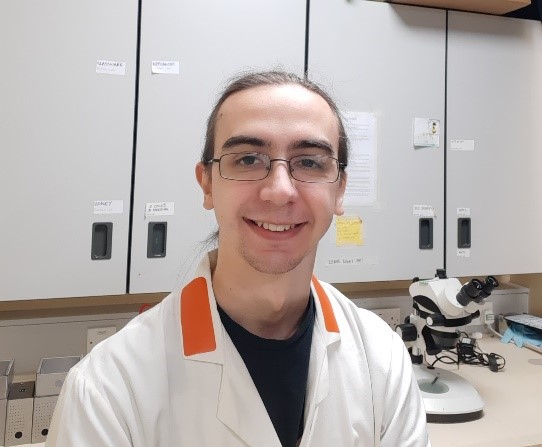Biography
I am a PGR based in the School of Biology within the Faculty of Biological Sciences at the University of Leeds. I am working with Dr Elizabeth Duncan investigating how, in eusocial insects like the honeybee, communication chemicals (known as pheromones) repress reproduction in subordinate females – which is the key to the evolution of this remarkable life history strategy. I completed my Integrated Masters in Biochemistry (with Research placement) at the University of Sussex. I enjoy playing the guitar, looking after my ants, and volunteering at a local Social action group (the St Vincent de Paul society)
Qualifications
2015-2019: MSci in Biochemistry (With research placement) at the University of Sussex
Research Interests
I research the molecular basis of eusociality (a type of advanced social structure, primarily characterised by reproduction being undertaken by a minority of individuals: the reproductive division of labour), with emphasis on pheromones and genetics more widely, and how they impact development and sexual development in particular. I have a broad interest in molecular biology, looking at metabolism of bacteria and yeast, as well as insects especially. I have particular interest in eusocial organisms (with the hymenopteran eusocial insects most so) and have been active in researching pollinator ecology for several years.
Teaching interests
I am interested in teaching basic developmental biology, structural biology, biochemistry and molecular biology, entomology, eusocial biology, and evolutionary developmental biology. (and tutor many of these currently)
Project Title
Learning to communicate: How do pheromones work in social and solitary bees and how did they evolve?
Supervisors
Dr Elizabeth Duncan
Dr Amanda Bretman
Funding
Panorama NERC DTP, 2020
Project outline
Eusociality, a highly organised social structure in which one female (the dominant or queen) is responsible for all of the reproduction while other females (the workers) perform all of the other tasks associated with the colony.
Most of the individuals in these social systems seem to “willingly” give up their ability to reproduce, which is at odds with the understanding that individual organisms are always acting in their own reproductive interest (a corner stone of Darwinian natural selection). In eusocial insects this “reproductive constraint” is mediated by pheromones produced by both the reproductive castes, and the larvae within the colony, which prevent the ovaries of the non-reproductives from developing.
In fact the Western honeybee (Apis mellifera) queen produces a well characterised set of pheromones, called Queen Mandibular Pheromone (QMP) that not only inhibits the ovary development of her own workers (alongside many other effects in the colony), but also inhibits the ovary development of the other eusocial hymenopteran insects (the ants, wasps, and bumblebees; despite the fact that these organisms have very different queen pheromones), the ovary development of fruit flies, and even some species of shrimp.
My project is looking at whether these different queen and larval pheromones act commonly act on a wide range of species and what this can tell us about how these pheromones are acting. Also, what implications does that have for the evolution of eusociality as a whole (especially with regards to whether these pheromones evolved as an honest signal of the queen’s fertility, or were they more to do with her controlling the workers against their own interests) and how are these pheromones actually working within the insects to prevent ovary development. My project will also include some investigation in to how these pheromones are produced within the insects themselves (at a metabolic and a genetic level).
